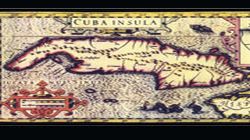Exhibition of provocative paintings in the national museum of Cuban art
- Submitted by: admin
- Arts and Culture
- Caribbean
- culture an traditions
- Destinations
- Education
- Havana
- history
- national
- Paint and Sculpture
- Society
- 08 / 02 / 2008

This seems to be an endless, protracted and irresolvable controversy, because these so extreme stances seem irreconcilable, however, most people living in Cuba consider it a privilege due to a happy conspiracy among natural, geographic, historic and even mystic facts.
Digressions apart, an island is something fascinating and everyone has its private one, which they situate in their preferred latitude, fill with the plants and animals of their dreams and turn into love nest to share with our beloved ones.
One of the sharpest provocations to creative minds is no doubt the exhibition “Cartographies of an overseas island (1560-2008)” exhibited in the National Fine Arts Museum, in its Cuban Art building.
The exhibit focuses on two high points in the history of Cuban iconography: the foundational one of the first maps drew by European cartographers from the colonial times and when the Cuban artists in the ‘80s decided to taken that icon with renewed intentions.
All of them (maps and paintings) mixed up in the hall, are an irresistible provocation for those concerned about the essence of what is Cuban and its root expressions in a journey of more than five centuries that is still far from ended.
There there are materialized the desires of conquest, the enormous task of naming the unknown in the work of cartographers like Francesco Bertelli, from 1560, who gives us an unrecognizable, fabulous island, with nonexistent elevations and geographical feature resultant from his fantasy.
We see how gradually the outlines start to come closer to reality, until in 1840 John Stephenson gives us the unforgettable figure of a long green alligator that floats on the Caribbean with a definitive profile.
If that magic with the “scientific” work of the cartographers amazes us, what to say then about the offers of the artists, in which the icon of the island transcends toward subjective, spiritual, political and even idealistic fields?
You need to stop then, before La marcha del pueblo combatiente (1980), by Manuel Castellano, the portrait of a severe moment we lived in these parts, or before La isla del tesoro (1992), by Lázaro Saavedra, charged of insinuations and possible interpretations.
Antonio Eligio Fernández (Tonel) also gives us very conceptual, suggestive and even humorous visions in his paintings El bloqueo (1989), Cuba (1991) and Dos Cubas (1991).
And Alexis Leyva (Kcho) with his Plan Jaba (1991) and Archipiélago (2003) invites us to think about essences.
We could also opt for the poetic Noche insular, jardines invisibles (1993), by Ibrahim Miranda or by the visceral link of Esterio Segura in Sobre cómo aprendió a caminar la tierra (2008).
In Alas (2008), by Douglas Rodríguez, the artist who deals with a lack of inhibition only understandable in the personality of a common Cuban, as curator Arlet Ojeda says, you find references to mutations and dualities.
While René Francisco, with his Pozo de Cuba (1997), make references to the Special Period and the construction of the Cuban socioeconomic plan.
Constant and sharp provocations in the exhibition “Cartographies of an overseas island”, which no doubt will shake those of us who know this island is much more than a profile and its toponyms: it is also a very special way of facing existence.
(Cubarte)
Comments